复习动词-ing形式的用法概要
- 格式:ppt
- 大小:514.00 KB
- 文档页数:18
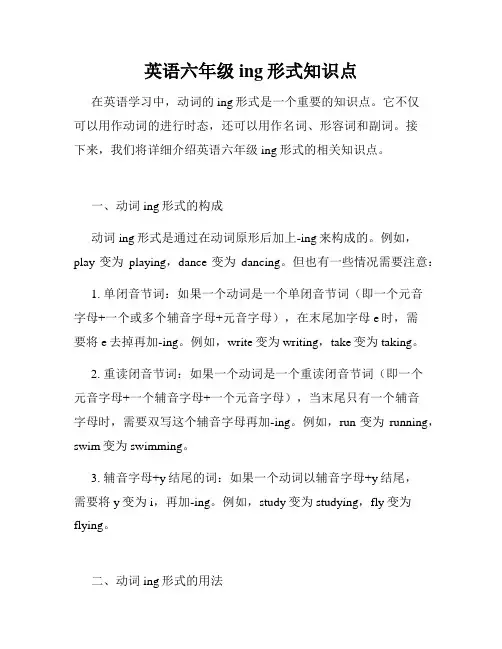
英语六年级ing形式知识点在英语学习中,动词的ing形式是一个重要的知识点。
它不仅可以用作动词的进行时态,还可以用作名词、形容词和副词。
接下来,我们将详细介绍英语六年级ing形式的相关知识点。
一、动词ing形式的构成动词ing形式是通过在动词原形后加上-ing来构成的。
例如,play变为playing,dance变为dancing。
但也有一些情况需要注意:1. 单闭音节词:如果一个动词是一个单闭音节词(即一个元音字母+一个或多个辅音字母+元音字母),在末尾加字母e时,需要将e去掉再加-ing。
例如,write变为writing,take变为taking。
2. 重读闭音节词:如果一个动词是一个重读闭音节词(即一个元音字母+一个辅音字母+一个元音字母),当末尾只有一个辅音字母时,需要双写这个辅音字母再加-ing。
例如,run变为running,swim变为swimming。
3. 辅音字母+y结尾的词:如果一个动词以辅音字母+y结尾,需要将y变为i,再加-ing。
例如,study变为studying,fly变为flying。
二、动词ing形式的用法1. 进行时态:动词ing形式可以用作动词的进行时态。
例如,He is playing soccer.(他正在踢足球。
)2. 名词用法:动词ing形式可以作为名词使用。
例如,I enjoy swimming.(我喜欢游泳。
)这里的swimming是动名词,表示一个活动或动作。
3. 形容词用法:动词ing形式可以作为形容词使用。
例如,The movie was very exciting.(这部电影非常令人激动。
)这里的exciting表示令人激动的。
4. 副词用法:动词ing形式可以作为副词使用,用来修饰动词、形容词或其他副词。
例如,She ran quickly.(她跑得很快。
)这里的quickly是一个副词,修饰动词ran。
三、动词ing形式的注意事项1. 特殊动词:有一些动词本身就是以ing形式存在的,如go (去)和see(看)。

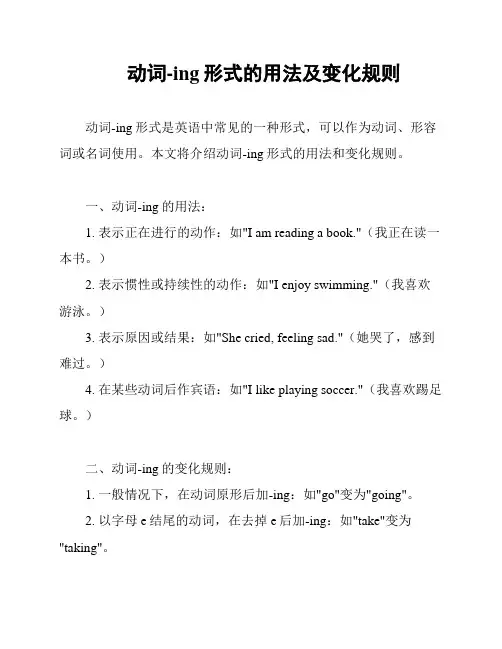
动词-ing形式的用法及变化规则
动词-ing形式是英语中常见的一种形式,可以作为动词、形容词或名词使用。
本文将介绍动词-ing形式的用法和变化规则。
一、动词-ing的用法:
1. 表示正在进行的动作:如"I am reading a book."(我正在读一本书。
)
2. 表示惯性或持续性的动作:如"I enjoy swimming."(我喜欢游泳。
)
3. 表示原因或结果:如"She cried, feeling sad."(她哭了,感到难过。
)
4. 在某些动词后作宾语:如"I like playing soccer."(我喜欢踢足球。
)
二、动词-ing的变化规则:
1. 一般情况下,在动词原形后加-ing:如"go"变为"going"。
2. 以字母e结尾的动词,在去掉e后加-ing:如"take"变为"taking"。
3. 写法为辅音字母+元音字母+辅音字母结尾的重读闭音节的动词,应双写最后一个辅音字母,再加-ing:如"run"变为"running"。
4. 以重读闭音节结尾,且末尾只有一个辅音字母的动词,应双写末尾辅音字母,再加-ing:如"swim"变为"swimming"。
总之,动词-ing形式在英语中的用法丰富多样,掌握好用法和变化规则,有助于提升语言表达的准确性和流畅性。
(以上内容仅供参考,不作为法律依据。
)。
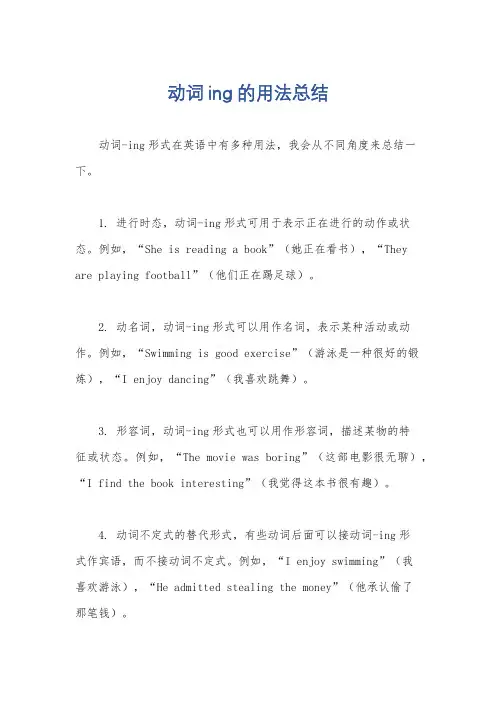
动词ing的用法总结动词-ing形式在英语中有多种用法,我会从不同角度来总结一下。
1. 进行时态,动词-ing形式可用于表示正在进行的动作或状态。
例如,“She is reading a book”(她正在看书),“They are playing football”(他们正在踢足球)。
2. 动名词,动词-ing形式可以用作名词,表示某种活动或动作。
例如,“Swimming is good exercise”(游泳是一种很好的锻炼),“I enjoy dancing”(我喜欢跳舞)。
3. 形容词,动词-ing形式也可以用作形容词,描述某物的特征或状态。
例如,“The movie was boring”(这部电影很无聊),“I find the book interesting”(我觉得这本书很有趣)。
4. 动词不定式的替代形式,有些动词后面可以接动词-ing形式作宾语,而不接动词不定式。
例如,“I enjoy swimming”(我喜欢游泳),“He admitted stealing the money”(他承认偷了那笔钱)。
5. 表示原因或条件,动词-ing形式可以用来表示原因或条件。
例如,“Being tired, she went to bed early”(因为累了,她早早就上床睡觉了),“Without studying, you won't pass the exam”(不学习的话,你就通不过考试)。
总的来说,动词-ing形式在英语中有多种用法,包括进行时态、动名词、形容词、动词不定式的替代形式以及表示原因或条件等。
掌握这些用法可以帮助我们更准确地理解和运用动词-ing形式。
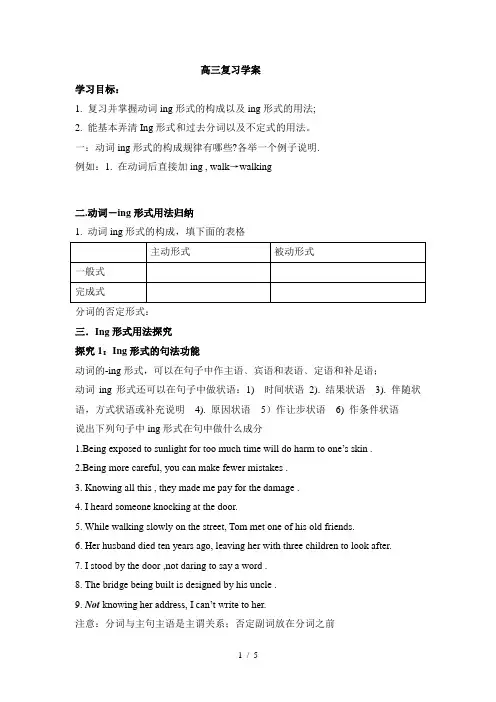
高三复习学案学习目标:1. 复习并掌握动词ing形式的构成以及ing形式的用法;2. 能基本弄清Ing形式和过去分词以及不定式的用法。
一:动词ing形式的构成规律有哪些?各举一个例子说明.例如:1. 在动词后直接加ing , walk→walking二.动词-ing形式用法归纳1. 动词ing形式的构成,填下面的表格分词的否定形式:三.Ing形式用法探究探究1:Ing形式的句法功能动词的-ing形式,可以在句子中作主语﹑宾语和表语﹑定语和补足语;动词ing形式还可以在句子中做状语:1) 时间状语2). 结果状语3). 伴随状语,方式状语或补充说明4). 原因状语5)作让步状语6) 作条件状语说出下列句子中ing形式在句中做什么成分1.Being exposed to sunlight for too much time will do harm to one’s skin .2.Being more careful, you can make fewer mistakes .3. Knowing all this , they made me pay for the damage .4. I heard someone knocking at the door.5. While walking slowly on the street, Tom met one of his old friends.6. Her husband died ten years ago, leaving her with three children to look after.7. I stood by the door ,not daring to say a word .8. The bridge being built is designed by his uncle .9. Not knowing her address, I can’t write to her.注意:分词与主句主语是主谓关系;否定副词放在分词之前探究2 ing形式用在with 复合结构和独立主格结构中1.with 的复合结构The policemen made their way into the forest with a hunter leading the way.知识拓展:with复合结构与其他非谓语动词形式的运用With his eyes fixed on the wall, Tom lay on the floor.With a lot of work to deal with , Jim can’t go out with his friends.2. 独立主格结构If weather permits, we will go out for a picnic tomorrow.=Weather permitting, we will go out for a picnic tomorrow.There is nobody in the room. Come in and have a chat.=There being nobody in the room, come in…知识拓展1.在动词ing形式前可加连词为了强调与谓语动词同时发生,在动词的-ing 之前可用when或while;为强调在谓语动词之前或之后发生,在动词的-ing 之前可用before或after.E.g. Don’t laugh, while eating.Before going abroad, he studied in Peking University.After watching TV, he went to bed.2 在动词的-ing 之前可用on或upon, 表示”一….就…”.E.g. On/Upon arriving in Bejing, he went to see his uncle.3.为了强调结果, 可在动词的-ing 之前用thus.E.g. My friend Lucy works hard, thus getting praised by her boss.4. 在动词的-ing 之前可用though或although,E.g. Though working hard, he couldn’t make enough money to pay off his debts. 探究3 动词ing的一般式与完成式,主动与被动形式在句中的运用1) 动词-ing形式的一般式表示动作与谓语动词同时发生﹑几乎同时发生或在谓语动词前发生。
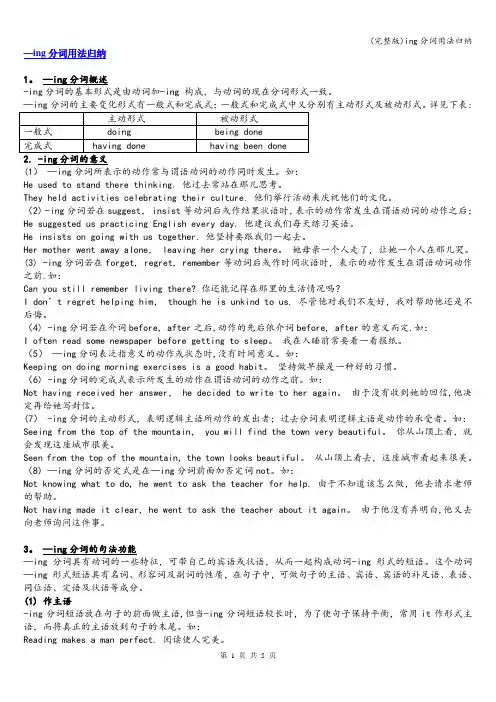
—ing分词用法归纳1。
—ing分词概述-ing分词的基本形式是由动词加-ing 构成,与动词的现在分词形式一致。
详见下表:2. -ing分词的意义(1)—ing分词所表示的动作常与谓语动词的动作同时发生。
如:He used to stand there thinking. 他过去常站在那儿思考。
They held activities celebrating their culture. 他们举行活动来庆祝他们的文化。
(2) -ing分词若在suggest, insist等动词后或作结果状语时,表示的动作常发生在谓语动词的动作之后;He suggested us practicing English every day. 他建议我们每天练习英语。
He insists on going with us together. 他坚持要跟我们一起去。
Her mother went away alone, leaving her crying there。
她母亲一个人走了,让她一个人在那儿哭。
(3) -ing分词若在forget, regret, remember等动词后或作时间状语时,表示的动作发生在谓语动词动作之前.如:Can you still remember living there? 你还能记得在那里的生活情况吗?I don’t regret helping him, though he is unkind to us. 尽管他对我们不友好,我对帮助他还是不后悔。
(4) -ing分词若在介词before, after之后,动作的先后依介词before, after的意义而定.如:I often read some newspaper before getting to sleep。
我在入睡前常要看一看报纸。
(5)—ing分词表泛指意义的动作或状态时,没有时间意义。
如:Keeping on doing morning exercises is a good habit。
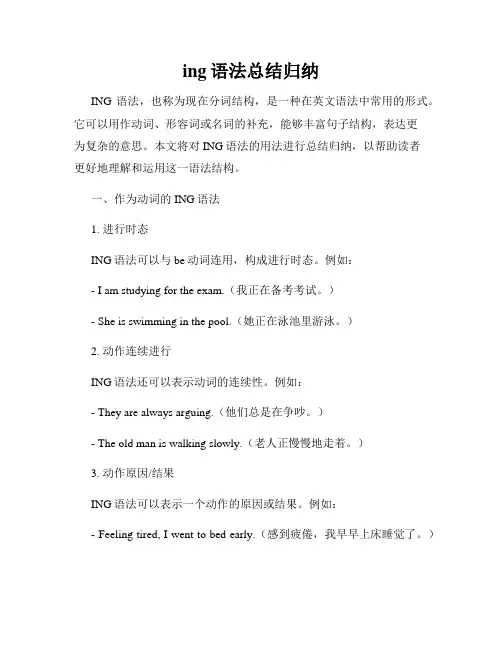
ing语法总结归纳ING语法,也称为现在分词结构,是一种在英文语法中常用的形式。
它可以用作动词、形容词或名词的补充,能够丰富句子结构,表达更为复杂的意思。
本文将对ING语法的用法进行总结归纳,以帮助读者更好地理解和运用这一语法结构。
一、作为动词的ING语法1. 进行时态ING语法可以与be动词连用,构成进行时态。
例如:- I am studying for the exam.(我正在备考考试。
)- She is swimming in the pool.(她正在泳池里游泳。
)2. 动作连续进行ING语法还可以表示动词的连续性。
例如:- They are always arguing.(他们总是在争吵。
)- The old man is walking slowly.(老人正慢慢地走着。
)3. 动作原因/结果ING语法可以表示一个动作的原因或结果。
例如:- Feeling tired, I went to bed early.(感到疲倦,我早早上床睡觉了。
)- Being well-prepared, they won the competition.(他们做好了充分的准备,赢得了比赛。
)4. 注意动词词义改变有些动词在ING形式时,会有词义上的改变。
例如:- go(去) -> going(进行中)- run(跑) -> running(运行)- do(做) -> doing(进行中)二、作为形容词的ING语法1. 描述人或物的特征ING语法可以用来描述人或物的特征。
例如:- She is an interesting person.(她是个有趣的人。
)- The movie was boring.(那部电影很无聊。
)2. 表示造成某种感受的原因ING语法可以用来表示某种感受的原因。
例如:- The story is heartwarming.(这个故事让人感动。
)- The weather is refreshing.(天气令人神清气爽。
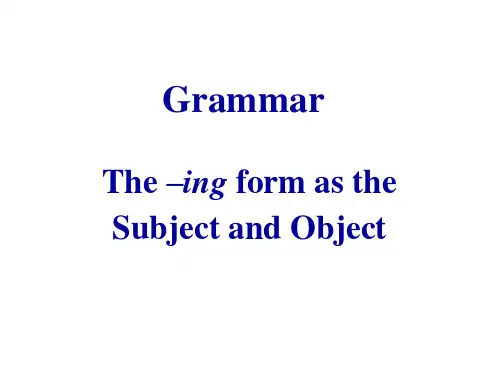
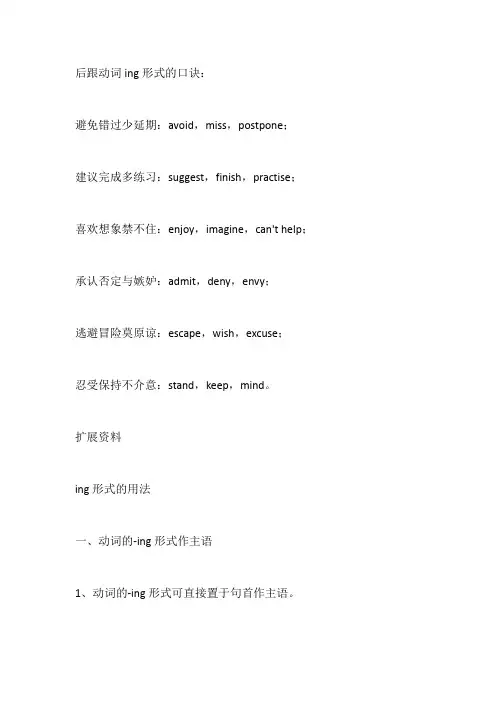
后跟动词ing形式的口诀:
避免错过少延期:avoid,miss,postpone;
建议完成多练习:suggest,finish,practise;喜欢想象禁不住:enjoy,imagine,can't help;承认否定与嫉妒:admit,deny,envy;
逃避冒险莫原谅:escape,wish,excuse;
忍受保持不介意:stand,keep,mind。
扩展资料
ing形式的用法
一、动词的-ing形式作主语
1、动词的-ing形式可直接置于句首作主语。
Seeing is believing.
百闻不如一见。
2、为了保持句子平衡,通常用先行词it作形式主语,而把真正的主语放在句末。
It is easy making plans, but it is difficult carrying them.
制定计划很容易,实行它却很难。
二、动词的-ing形式作表语
动词的-ing形式作表语的有两种不同的含义:
1、表示主语的内容是什么。
2、表示主语具有的特征。
三、动词的-ing形式作宾语
动词的-ing形式既可作及物动词的宾语,也可作介词的宾语。
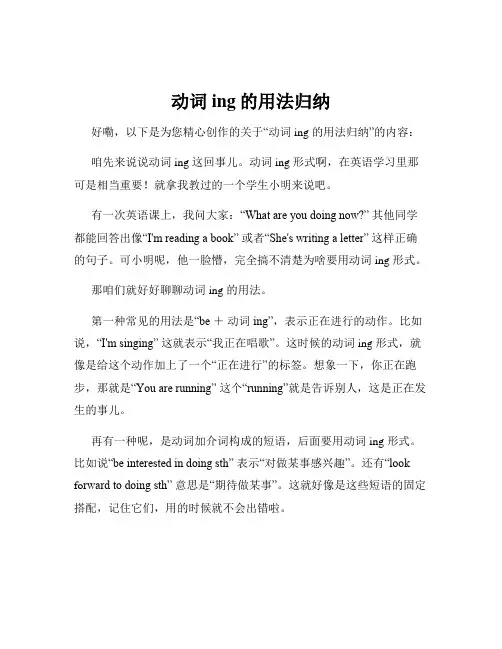
动词ing的用法归纳好嘞,以下是为您精心创作的关于“动词 ing 的用法归纳”的内容:咱先来说说动词 ing 这回事儿。
动词 ing 形式啊,在英语学习里那可是相当重要!就拿我教过的一个学生小明来说吧。
有一次英语课上,我问大家:“What are you doing now?” 其他同学都能回答出像“I'm reading a book” 或者“She's writing a letter” 这样正确的句子。
可小明呢,他一脸懵,完全搞不清楚为啥要用动词 ing 形式。
那咱们就好好聊聊动词 ing 的用法。
第一种常见的用法是“be +动词ing”,表示正在进行的动作。
比如说,“I'm singing” 这就表示“我正在唱歌”。
这时候的动词 ing 形式,就像是给这个动作加上了一个“正在进行”的标签。
想象一下,你正在跑步,那就是“You are running” 这个“running”就是告诉别人,这是正在发生的事儿。
再有一种呢,是动词加介词构成的短语,后面要用动词 ing 形式。
比如说“be interested in doing sth” 表示“对做某事感兴趣”。
还有“lookfo rward to doing sth” 意思是“期待做某事”。
这就好像是这些短语的固定搭配,记住它们,用的时候就不会出错啦。
还有哦,像“go +动词ing”,表示去做某种活动。
比如“go swimming”去游泳,“go shopping”去购物。
就好像是给“go”这个词找了个小伙伴一起玩耍。
另外,有些动词后面就是得接动词 ing 形式,像“enjoy doing sth” 喜欢做某事,“finish doing sth” 完成做某事。
这可没有什么太多的道理,就是语言的习惯,咱们得记住。
就像我之前说的小明,他后来通过努力学习,终于搞清楚了这些用法。
有一次英语考试,有一道题是“He is good at (play)football” 小明毫不犹豫地写上了“playing”,这可把他高兴坏了。
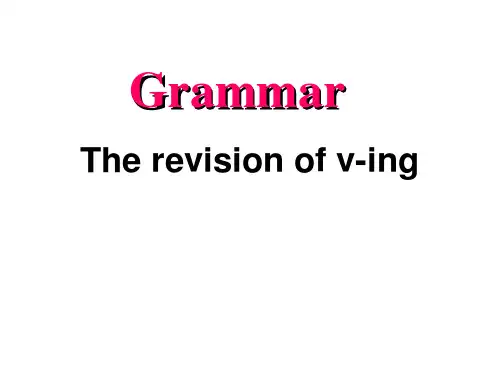
动词-ing形式的用法在句子中的位置动词-ing形式是英语中常见的一种形式,它可以用作动词、名词、形容词或副词。
在句子中,动词-ing形式的用法位置有以下几种情况:1. 作主语:动词-ing形式可以作为主语出现在句子中。
例如:作主语:动词-ing形式可以作为主语出现在句子中。
例如:- Swimming is my favorite sport.(游泳是我最喜欢的运动。
)- Dancing helps me relax.(跳舞帮助我放松。
)2. 作宾语:动词-ing形式可以作为及物动词的宾语。
例如:作宾语:动词-ing形式可以作为及物动词的宾语。
例如:- I enjoy reading books.(我喜欢读书。
)- She hates doing homework.(她讨厌做作业。
)3. 作表语:动词-ing形式可以作为表语出现在句子中,表示主语的状态或特征。
例如:作表语:动词-ing形式可以作为表语出现在句子中,表示主语的状态或特征。
例如:- His favorite activity is playing soccer.(他最喜欢的活动是踢足球。
)- The most interesting thing about him is his singing ability.(关于他最有趣的事情就是他的唱歌能力。
)4. 作定语:动词-ing形式可以作为定语修饰名词或代词。
例如:作定语:动词-ing形式可以作为定语修饰名词或代词。
例如:- The running water is very clear.(流动的水非常清澈。
)- She bought a loving gift for her mother.(她给妈妈买了一个充满爱意的礼物。
)5. 作状语:动词-ing形式可以作为状语修饰动词、形容词或副词,表示时间、原因、条件等。
例如:作状语:动词-ing形式可以作为状语修饰动词、形容词或副词,表示时间、原因、条件等。
ing形式的用法ing形式的用法如下:动词加ing的规则口诀:动词ing形式的变化规则主要有八种,分别是:动词加+ing;双写最后的辅音字母再加+ing;不发音字母e结尾的动词去掉e再加+ing;y结尾的动词直接+ing;以ie 结尾的动词改ie为y再加+ing等。
表达将来时的几种结构如下:01. be going to do表示最近打算进行的事,具有一定的目的性和计划性.(这种安排既有可能是主语做出的,也有可能是别人安排的)We are going to have a meeting tomorrow.表示即将要发生的事情,不可避免要发生的事情.(多用于表天气)It's getting cloudy. It is going to rain.02. be to do表示按计划要发生的事,一般认为,这种计划是双方约定的,而 be going to do 所指的安排不一定是双方约定的.We are going to meet them at the north of the bridge, because it is the only road they can follow. 我们打算去桥的北边堵他们,因为那是他们的必经之路.We are to meet each other with them at the north end of the bridge. 双方约定好要在桥的北边见面.be to do 还有很多情态用法,be going to do 没有以下用法.You are to wash your hands before every meal.(表需要=needAs Warrent's parents,you are to set a good example tohim.(表责任,义务,相当于,must should) Are we to clean the corridor,Mrs Dell? (表征求意见=shall)The temperature is to drop soon.(表示可能性)Would she get cross if I were to sail into her of lying?(表假设)。
动词ing形式知识点总结一、动词的ing形式的构成动词的ing形式一般是在动词原形的基础上加上-ing后缀来构成的。
例如:walk → walkingeat → eatingwrite → writing但是也有一些不规则的情况,如:go → goingrun → runningswim → swimming动词的ing形式可以作为动名词使用,表示动作或状态的进行或延续。
它还可以用作动词短语、现在分词或复合动词的一部分,具体用法将在接下来的内容中详细介绍。
二、动词的ing形式在进行时态中的用法1. 表示正在进行的动作动词的ing形式可以用于进行时态,表示正在进行的动作。
例如:He is reading a book.(他正在看书。
)She is writing an article.(她正在写一篇文章。
)They are playing basketball.(他们正在打篮球。
)2. 表示一段时间内延续进行的动作动词的ing形式也可以表示一段时间内延续进行的动作。
例如:I have been studying English for five years.(我已经学习英语五年了。
)She has been working here since last month.(她上个月就在这工作了。
)They have been living in this city for a long time.(他们在这座城市住了很长时间。
)3. 注意事项在进行时态中,be动词的形式(am/is/are)加上动词的ing形式构成句子的谓语部分。
同时,进行时态也对时间状语有一定的限制,表示正在进行的动作必须是在说话时或与说话时有关的时间内进行的。
例如:I am studying English.(表示正在进行的动作)I was studying English when he called.(表示过去正在进行的动作)三、动词的ing形式在现在分词和动词短语中的用法1. 作为现在分词使用动词的ing形式可以作为现在分词使用,充当形容词修饰名词或代词。
有关ing知识点总结一、ing的基本用法ing是一个非常常见的词尾,在英语中用来构成动名词和现在分词。
动名词表示的是动作的持续性或正在进行性,常用来作主语、宾语或介词宾语。
现在分词是一种形容词,用来修饰名词或代词,表示状态或特征。
1. 动名词的构成动名词的构成规则是在动词原形的基础上加上-ing。
例如:read → reading,write → writing,study → studying。
2. 动名词的用法a. 主语:Reading is my favorite hobby.b. 宾语:I like reading books.c. 介词宾语:I am good at singing.3. 现在分词的构成现在分词的构成规则也是在动词原形的基础上加上-ing。
例如:play → playing,dance → dancing,swim → swimming。
4. 现在分词的用法a. 修饰名词:The crying baby needs attention.b. 修饰代词:I saw him running in the park.二、ing的时态用法ing形式的动词可以表示进行时或完成时,具体的时态和语态要根据上下文确定。
1. 进行时进行时表示某一动作或状态正在进行中,通常用于现在进行时和过去进行时。
a. 现在进行时:I am reading a book.b. 过去进行时:She was studying when I called her.2. 完成时完成时用于表示一个已经完成的动作或状态,通常用于现在完成进行时和过去完成进行时。
a. 现在完成进行时:She has been working here for 5 years.b. 过去完成进行时:I had been studying for 2 hours when he came back.三、ing的被动语态ing形式的动词也可以构成被动语态,形式为be + being + 过去分词。
动词ing知识点总结动词ing形式,在英文语法中是一种非常重要的形式,它有多种不同的用法和功能。
在本篇文章中,我们将深入探讨动词ing形式的各种用法和知识点,帮助读者更好地掌握和使用这一语法结构。
一、动词ing形式的基本构成动词ing形式的构成非常简单,大多数情况下是在动词原形的基础上加上ing后缀。
例如:- walk → walking- eat → eating- play → playing但是也有一些特殊的变化规则,比如以“e”结尾的动词要去掉最后的“e”再加上ing,比如:- take → taking- make → making- write → writing还有一些以辅音字母加“ie”结尾的动词,要将“ie”变为“y”再加上ing,比如:- die → dying- lie → lying总的来说,动词ing形式的构成规则比较简单,但需要注意一些特殊变化规则。
二、动词ing的用法动词ing形式具有多种不同的用法和功能,下面将详细介绍每一种用法。
1. 动词ing 作谓语动词动词ing形式可以作为谓语动词,表示正在进行的动作。
例如:- He is reading a book.- They are playing basketball.2. 动词ing 作动名词动词ing形式也可以作为名词使用,这就是动名词。
动名词可以作为主语、宾语、表语、介词宾语等。
例如:- Swimming is good exercise.- I enjoy reading novels.- She is good at singing.3. 动词ing 作形容词动词ing形式还可以作为形容词使用,表示给人或物的特征或状态。
例如:- The movie was boring.- The running water sounds soothing.4. 动词ing 用于进行时态在进行时态中,动词ing形式表示正在进行的动作。
-i n g分词的用法一、-ing分词的构成-ing分词是由动词原形加词尾-ing构成;-ing分词同样有时态和语态的变化,通常有下表几种形式以do为例:一般式完成式主动形式 doing 主动形式 having done被动形式 being done 被动形式 having been done-ing分词的否定形式是由not 加-ing分词构成;如:Not knowing his address, I could do nothing but stay at home and wait.不知道他的地址,我只好在家里等着;His not coming made all of us angry. 他没来使我们大家都很生气;1.-ing分词的一般式 doing1). 动词V-ing形式的一般式可用来泛指一个动作,没有特别的时间意义;Eg:Learning is important to modern life.学习对现代生活很重要;Eg:Swimming is her favorite sport.游泳是她最喜欢的体育运动;2.-ing分词的一般式表示和谓语动词所表示的动作同时进行的动作;Eg:Being a student, he was interested in books. 作为一个学生,他对书本很感兴趣;Eg:They went out of the classroom, talking and laughing. 他们有说有笑地走出教室;2.-ing分词完成式 having done:完成式表示动作在谓语动词所表示的动作之前发生的动作;Eg:Not having studied his lessons very hard, he failed the examinations. 因为没有努力学习功课,他考试不及格;Eg:Having answered the letter, she went on to read an English novel.Eg:Having lived in this city for three years, she knows it very well.3. -ing分词的被动式 being done :-ing分词的被动式表示它的逻辑主语是-ing分词动作的承受者;被动语态-ing一般式所表示的动作是一个正在进行中的被动动作. Eg:The question being discussed is very important. 正在被讨论的问题很重要;4. having done的被动形式having been done表示它的逻辑主语是动词-ing形式表示的动作的承受者;表示动作在谓语表示的动作之前发生;Eg:Having been criticized by the teacher, he gave up smoking. 被老师批评以后,他把烟戒了;Eg:Having been shown the lab, we were taken to see the schoollibrary.在被带去看了实验室之后,我们又被带去参观校图书馆;5动词-ing形式的否定形式;动词-ing形式的否定形式通常是在其前加not,带有逻辑主语时not 应放在动词-ing形式之前;Eg:Excuse me for my not coming on time.Eg:I’m sorry for not having kept my promise.例1. ______ to the station on time made everyone wor ried last week.A. Him not gettingB. Not his gettingC. His not gettingD. Not getting6.动词-ing形式的复合结构动词ing形式的复合结构由形容词性物主代词或人称代词宾格,名词所有格或普通格加动名词,动名词的复合结构实际上是给动名词加了一个逻辑主语; 动词-ing形式的复合结构有四种形式:①形容词性物主代词+动名词②名词‘s +动名词③代词宾格+动名词④名词+动名词注意动名词的复合结构可在句中作主语或宾语;作主语时,不能用③④两种形式;Eg:Tom’s winning the first prize last year impressed me a lot. 汤姆去年得了一等奖使我印象深刻;Eg:Do you mind my/me/Jack’s/Jack leaving now.翻译练习:His coming made us very happy. 他的到来使我们大家都很高;翻译练习:He was awakened by someone’s knocking at the door. 他被某人的敲门声吵醒了;二 -ing分词的语法作用动词-ing一方面具有动词的性质,另一方面也相当于一个名词或形容词、副词,在句中可以作主语、表语、宾语、定语、状语和补语等; 1–ing分词短语作主语: 动词ing形式作主语往往表示经常性、习惯性的动作,谓语动词用单数:Eg:Reading books widens our knowledge.读书增长我们的知识Eg:Saying is easier than doing. 说比做容易;翻译练习:Learning English well is not easy.在下面两种结构中,-ing分词也作主语;A.It is no use/no good/useless/worthwhile/dangerous/a wa ste of time /fun等后需用动名词作真正的主语;为了保持句子平衡,通常用it 作形式主语,而把真实主语放在句末;Eg:It is no use crying over spilt milk. 覆水难收Eg:It's a waste of time arguing about it. 辩论这事是浪费时间;翻译练习:It is no use waiting for him any longer.B.当句型“There is no doing…”表示“不允许、禁止某种行为的发生或存在”时,需用动名词作主语;Eg:There is no joking about such matters. 这种事开不得玩笑;There is no point indoing sth 干…….没意义; Eg:There’s no point in waiting. 等待是毫无意义的; There is no senseindoing sth. 干…没道理/意义例.1.In my mind,_____ that famous university will be the only way to become a worlds-class writer. A. attending B.to attend C. attendD. having attended2. My grandfather is a millionaire, but _____ money does not solve all his problem.A. hasB. to haveC. havingD. having had2 -ing分词短语作表语:Eg:His hobby is collecting stamps. 他的爱好是收集邮票; Eg:The problem is quite puzzling. 这个问题很令人困惑;3 -ing分词作宾语:①–ing分词可作动词宾语, 作动词的宾语;mind介意, suggest建议, enjoy欣赏,, admit承认, appreciate 感激,欣赏, avoid避免, delay推迟, dislike不喜欢,厌恶, escape 逃脱, finish完成, forgive宽恕, imagine想象, keep保持, miss 错过, practise训练, resist抵抗,抵制, risk冒险, deny拒绝,否认, consider考虑等;Eg:I suggest doing it in a different way. 我建议用另一种方法做这件事;Eg:We enjoy attending Miss Li''s class. 我们喜欢听李老师的课;例1:He got well-prepared for the job interview, for he couldn’t risk _____ the good opportunity.A. to loseB. losingC. to be lostD. being lost答案B.后risk 后接动名词,he与 lose是主谓关系;2:Bill suggested _____ a meeting on what to do for the Shanghai Expo during the vacation.A. having heldB. to holdC. holdingD. hold3.To improve your spoken English, you should practic e_____ it every day. A. speak B. to be spo ken C. speaking D. to speak②-ing分词作宾补,也可用在复合宾语中作真正的宾语,而用it作形式宾语;如:Eg:I don’t think it possible living in such a cold place. 我认为住在这么寒冷的地方是不可能的;Eg:Do you consider it any good trying again 你觉得再试一次会有好处吗③-ing分词作介词宾语,经常用在一些短语的后面;如:Eg:I'm against inviting him to dinner. 我反对邀请他来吃饭; Eg:They don’t feel like walking that much. 他们不喜欢走那么多路;翻译练习:Don’t be afraid of speaking English.不要害怕说英语;此类短语还有很多;如:can’t help忍不住be proud of以……自豪, be responsible for对……负责, insist on坚持, keep on 继续think of考虑,想到, dream of梦想, hear of听说, prevent…from防止,阻止, keep…from防止,阻止, stop…from防止,阻止, be engaged in从事于, depend on依靠,依赖, thank…for因……而道谢, excuse…for因……而道歉, aim at目的在于, set about着手做, be fond of喜欢, be afraid of害怕, be tired of对……厌烦, succeed in成功地做……, be interested in对……感兴趣, be ashamed of对……感到羞愧, put off推迟, give up放弃, be worth值得做……, be busy in doing sth 忙于做某事 ,等等;注意:在有些句子中,介词常可省去;如:Eg:I have no difficulty in communicating with foreigners. 我在和外国人交谈方面没有什么困难;Eg:What can prevent us from getting married 有什么能阻止我们结婚翻译练习: Farmers were busy in getting in the crops. 农民在忙着收庄稼;翻译练习: I have never dreamed of visiting that place. 我从未梦想过要参观那个地方翻译练习: He used to spend a lot of time in playing games. 过去他常花很多时间玩游戏;例1.The girl said that she had never dream of _____a volunteer.A. beB. to beC. beingD. is2. I had great difficulty _____ the suitable food on the menu in that restaurant.A. findB. foundC. to findD. finding3. Seeing the funny scene, I can’t help______.A. laughB. to laughC. laughingD. laughed另外,-ing分词可以和一些介词如in, on, after, against, before, by, for, without, besides等构成短语,在句中作状语;如:Eg:He left ahead of time without saying a word. 他一句话也没说就提前离开了;Eg:Besides cooking and sewing, she had to take care of four children.除了做饭和缝纫以外,她还要照顾四个孩子;Eg:On hearing the news, all the pupils jumped with joy. 一听到这个消息后,所有的学生都高兴得跳了起来;4 -ing分词作定语:①单个的分词作定语一般放在被修饰词的前面,–ing分词作定语可用来说明被修饰的名词的用途和性能;如:reading material 阅读材料 walking stick 手杖 fishing pole 鱼杆flying suit 飞行服 writing table 写字台 listening practice 听力训练reading room 阅览室 swimming pool 游泳池 dining car 餐车sleeping car 卧车 singing competition 歌咏比赛 waiting room 候车室②-ing分词作定语还可以表示所修饰的人或物的动作或状态,在意思上接近一个定语从句,可以表示正在进行的动作,也可表示经常性动作或当时的状态;如:developing countries = countries that are developing 发展中国家a growing city = a city that is growing 发展着的城市Eg:Who is the student standing by the door 站在门边的同学是谁Eg:They lived in a house facing south.=They lived in a house which faces south. 他们住在一所朝南的房子里;翻译练习:坐在我旁边的女孩是我妹妹;The girl sitting beside me is my sister.翻译练习:有人在敲门There is someone knocking at the door.③–ing分词还可以作非限制性定语,相当于一个非限制性定语从句,常用逗号和句子其它部分分开;如:Eg:When she appeared, John, wearing a dirty and worn-out overcoat, ran to her with joy. 当她出现的时候,约翰穿着一件又脏又破的大衣高兴地跑了过去;5 -ing分词做状语:动词-ing形式作状语可以修饰谓语动词或整个句子,可以表示时间、原因、结果、条件、让步、方式或伴随情况等;①.表示时间:-ing分词短语作时间状语,相当于一个时间状语从句,有时可由连词when, while引出;Eg:Turning around, she saw a car driving up.=When she turned around, she saw a car driving up. 她转过身,看见一辆车朝她开来;Eg:While reading the book, he nodded from time to time. 他一边看书,一边不时地点头;翻译练习:看到那些画,他想起了她的童年;Seeing those pictures, she remembered her childhood.翻译练习: 听到这消息时我们高兴地跳了起来;Hearing the news, we jumped with joy.②表示原因:-ing分词短语作原因状语,相当于一个原因状语从句;Eg:Being tired, he could not walk any further.=As he wastired, he could not walk any further. 因为疲倦,他不能再往前走了;Eg:Not knowing his address, I can’t send this book to him. 因为不知道他的地址,我不能把这本书送给他;Eg:Many of us, being so excited, couldn’t go to sleep that night. 因为非常激动,那晚我们许多人都没睡着;翻译练习:因为不知道路,他无法到那里去;Not knowing the way, he could’t go there.翻译练习:因为激动他睡不着;Being excited , she couldn’t go to sleep.③表示结果:–ing分词短语作结果状语;表示一种必然的结果,可扩展为一个含有并列谓语的简单句;The fire lasted nearly a month, leaving nothing v aluable.=The fire lasted nearly a month, and left nothing valuable. 大火持续了近一个月,几乎没剩下什么值钱的东西; Eg:His father died, leaving him a lot of money. 他父亲死了,留给他许多钱;Eg:She was so angry that she threw the toy on the ground, breaking it into pieces.她非常生气,把玩具扔在地上,把它摔成了碎片;④表示伴随.-ing分词作伴随状语,可以放在句子的前面、后面或中间,表示主语的另一个、较次要的动作;如:Eg:I stood by the door, not daring to say a word.=I stood by the door, and did not dare to say a word. 我站在门旁,不敢说一句话;Eg:They stood there for half an hour,watching the stars in the sky. 他们在那儿站了半小时,观察着天上的星星;翻译练习:年轻人跟在老人的后面开始慢慢地走起来;Following the old man, the young people started walking slowly. 翻译练习:他们在那儿站了一个小时观看比赛;They stood there for an hour watching the game.⑤表示条件:动词-ing形式作条件状语,相当于一个条件状语从句;Being more careful, you can make fewer mistakes.=If you are more careful, you can make fewer mis takes. 更细心点,你就会少犯错误;Turning to the left, you ‘ll see the tower.向左转,你就会看到那座塔;翻译练习:如果努力,你就会成功;Working hard, you will succeed.⑥“with/without+名词普通格或代词宾格+-ing分词”结构在句中作状语,表示伴随情况或时间、原因等;如:Eg:His hair became gray with the years passing. 随着时间的推移,他的头发变花白了;Eg:Without anyone noticing, he slipped through the window. 没人注意,他从窗户溜了出去;例1.The storm left, ______ a lot of damage to this area.A. causedB. to have causedC. to causedD. having caused例2.----“You can’t catch me” Janet shouted, ______ away.A. runB. runningC. to runD. ran 例3.It’s necessary to be prepared for a job interview. ______ the answers ready will be of great help.A. To have hadB. Having hadC. HaveD. Having 例 4._____ from other continents for millions of years, Australia has many plants and animals not found in any other country in the world.A. Being separatedB. Having separatedC. Having been separatedD. To be separated例5.Daddy didn’t mind what we were doing, as long as we were together, _____ fun.A. hadB. haveC. to haveD. having 例6.Oil prices have risen by 32 percent since the start of the year, _____ a record $57.65 a barrel on April 4.A. have reachedB. reachingC. to reachD. to be reaching例7.It was unbelievable that the fans waited outside the gym for three hours just _____ a look at the sports stars.A. hadB. havingC. to haveD. have例8._____ more about university course, call 9207463789. A. To find out B. Finding out C. Find out D. Having found out简析:1.D.结果状语,时间有明显先后之分;2.B.伴随状语;3.D.条件状语,有明显时间先后之分;4.C.原因状语,时间有明显先后之分;5.D.伴随状语;6.B.结果状语;7.C.作目的状语;8.A.作目的状语;6 -ing分词作补语:--ing分词可以在see, hear, notice, watch, feel, look at, listen to, observe, have, get, leave, keep, set, catch, find等动词后面和一个名词或代词构成一个复合宾语,作宾语补语;如:Eg:I noticed a man running out of the bank when I got off the car.我下车的时候注意到一个男人匆匆忙忙地从银行里跑出来;Eg:Last night the shopkeeper caught a child stealing some food in the shop.昨晚,店主在商店里抓到一个小孩在偷东西;翻译练习:I saw him going upstairs.我看见他正在上楼;翻译练习:We watched her crossing the street. 我们看着她穿过大街;三. –ing分词作主语和表语时与不定式的区别:1、-ing分词和动词不定式作主语和表语的主要区别在于:在表示比较抽象的一般的多次性行为时多用-ing分词;在表示具体的或一次性的动作,特别是将来的动作时,多用不定式;如:Eg:Smoking is forbidden here. 泛指吸烟这里禁止吸烟;Eg:It’s not good for you to smoke so much. 指你吸烟吸这么多烟对你的身体不好;2、有些动词既能接不定式,又能接-ing分词,含义有所不同;如:Remember doing sth 记得做了某事Remember to do sth 记住要去做某事Forget doing sth 忘记做了某事Forget to do sth 忘记要去做某事Regret doing sth 后悔做了某事Regret to do sth 遗憾要去做某事Mean to do sth 打算做某事Mean doing sth意味着做某事Stop to do sth 停下来去做某事Stop doing sth 停止做某事Try to do sth 努力/企图做某事Try doing sth 试着做某事Eg:Do you remember seeing me before 你记得以前见过我吗Eg:Remember to lock the door when you leave. 离开时要记得锁门;Eg:I try not to think about that. 我尽量不去想那件事;Eg:Would you please try doing that again 请你再试一次好吗Eg:I mean to change it for another one. 我想换成另外一个; 翻译练习:Having finished the exercises, we went on to learn the new words in the next unit.做完练习以后,我们继续学习下一单元的单词;翻译练习:After a short rest, they went on working. 短暂地休息以后,他们又继续工作;翻译练习:Missing the train means waiting for another hour. 错过这班车就意味着再等一个小时;例 1. Never mind. Please try _____ the problem in another way.A. solveB. to solveC. being solvedD. solving例2. When asked by the police, he said that he remembered _____ at the party, but not _______.A. to arrive, leavingB. to arrive, to leaveC. arriving, leavingD. arriving, to leave答案 C.记得来过晚会,用arriving,但是后的动作仍然记得,用leaving.3、动词allow, advise, forbid, permit等可直接跟-ing分词作宾语,不可以接动词不定式作宾语,但可接不定式作宾语补语;如:Eg:We don’t permit smoking here. 我们这儿不允许吸烟;Eg:Please permit me to say a few words. 请允许我说几句话; 例1.---Can I smoke here----Sorry. We don’t allow_____ here.A. people smokingB. people smokeC. to s mokeD. smoking4、动词need, require, want作“需要”解时以及deserve作“值得”解时,后面接-ing分词或不定式的被动式;need / want/require/deserve doing=need/want/require/dese rve to be done Eg:The lake needs repairing/ to be repairedEg:These little children require looking after carefully/to be looked after carefully. 这些小孩需要细心地照料;翻译练习:Your shoes need cleaning/ to be cleaned. 你的鞋需要清洗一下了;翻译练习:The room wants cleaning/to be cleaned. 这个房间需要打扫;例:As a result of the serious flood, two-third of the buildings in the area______.A. need repairingB. needs to repairC. needs repairingD. need to repair5、动词like, hate, prefer等后面,如表示一般性动作,多用-ing 分词;如指特定的具体的某次动作,多用不定式;如:Eg:I like swimming, but I don’t like to swim with you. 我喜欢游泳,但我不喜欢和你一起游泳;Eg:I prefer walking to school every day. 我情愿每天步行去学校;Eg:I prefer to stay at home today. 今天我情愿呆在家里;6、-ing分词作表语的两种不同含义:①-ing分词作表语可以表示主语的内容是什么;Eg:Their job is building houses. 他们的工作是盖房子;Eg:The real question is getting to know the needs of the people. 真正的问题是了解人民的需要;②-ing分词作表语还可以表示主语所具有的特征;如:Eg:This story is very interesting. 这故事很有趣;Eg:The problem is quite puzzling. 这个问题很令人困惑;7、不定式和-ing分词作宾语补语的区别:在see, hear, feel, watch, notice等感官动词后,既可用-ing分词构成复合宾语,也可用不定式构成复合宾语,两者之间有一定的区别;用-ing分词时,表示动作正在进行;用不定式时,表示动作发生了,即动作的全过程结束了;如:Eg:Do you hear someone knocking at the door Someone isknocking at the door. 有人在敲门你听见了吗Eg:Do you hear someone knock at the door Someone knocked at the door just now. 你听见有人敲门了吗8、高中阶段常见的带介词to的短语,后接-ing分词或名词;如:look forward to渴望,盼望admit to承认, contribute to捐助、贡献, get down to着手做, give way to让位于,keep to 坚持、遵守, lead to 导致, take to从事, turn to 求助于, stick to忠于、坚持, point to指向、表明, see to 注意、处理, be used to 习惯于, devote oneself to 献身于, be equal to 胜任的、等于, be familiar to 为……熟悉be/get used to习惯于 object to反对,抗议pay attention to注意 .9、高中阶段有一些固定的-ing分词短语,如:generally speaking 一般来说, judging from…根据……来判断, considering…考虑到……, talking of…谈到……,提到……, supposing…假如……等,它们的逻辑主语和句子的主语不一致;这种短语可以被称之为句子的状语,也可当作一个插入语;如:Eg:Judging from his accent, he must come from Canada. 从他的口音看他一定来自加拿大;Eg:Considering how poor he was, we decided to let him attend the concert for free.考虑到他是多么的穷,我们决定让他免费听音乐会;Exercises:1. The officers narrowly escaped ___________in the hot battle.A. have killedB. to killC. to be killedD. being killed2.___________ the letter, he went out to post it.A. WritingB. Being writingC. Having writtenD. Written3. Don't you remember ___________A. seeing the man beforeB. to see the man beforeC. saw the man beforeD. to have seen the man before4. People couldn't help ___________ the foolish emperor in the procession.A. laugh atB. to laugh atC. laughing atD. laughing on5. We're looking forward ___________ the photo exhibition.A. to visitingB. to visitC. to having visitedD. visiting6. The girl ___________ under that tree is my sister.A. sittingB. sitsC. is sittingD. sat7. This sentence needs ___________ .A. a improvementB. improveC. improvingD. improved8. ___________ anything about the accident, he went to work as usual..A. Not knownB. Known notC. Knowing notD. Not knowing9. The next morning she found the man ___________ in bed, dead.A. lyingB. lieC. layD. laying10. There was terrible noise ___________ the sudden burst oflight.A. followedB. followingC. to be followedD. being followed11. The secretary worked late into the night, ___________ a long speech for the president.A. to prepareB. preparingC. preparedD. was preparing12. "Can't you read " Mary said ___________ to the notice.A. angrily pointingB. and point angrilyC. angrily pointedD. and angrily pointing13. How about two of us ___________ a walk down the gardenA. to takeB. takeC. takingD. to be taking14. ---I must apologize for ___________ahead of time. ---That's all right.A. letting you not knowB. not letting you knowC. letting you know notD. letting not you know15. ---You were brave enough to raise objections at the meeting. ---Well, now I regret ___________ that.A. to doB. to be doingC. to have doneD. having done16. Would you ___________ me your identification card, sirA. mind to showB. mind showingC. trouble to showD. trouble showing17. He suggested ___________ on Saturday.A. to have a meetingB. having a meetingC. a meeting to haveD. that having a meeting18. It is no good ___________ to come now. He is busy.A. if you ask himB. to ask himC. asking himD. that you ask him19. Although punctual himself, the professor was quite used ___________ late for his lecture.A. to have studentsB. for students to beC. for students' beingD. to students' being20. He dressed himself quickly and ___________ his schoolbag, went to school.A. carriedB. to carryC. carryingD. carries21. ___________ for several weeks, the city needed food.A. As having floodedB. being floodedC. Having been floodedD. To flood22. ___________ ill worried my parents greatly.A. I fellB. Me fallingC. My fallingD. I falling23. She is writing a letter to a friend of hers, ___________ him to attend the meeting.A. having invitedB. invitingC. to inviteD. invited24. Our town has dozens of factories, ___________several saw mills.A. includedB. are includingC. are includedD. including25. ___________ the classroom, the students went to theplayground to watch the football match.A. To cleanB. Having cleanedC. CleanedD. Cleaning语法专项练习二1.北京 ________in the queue for half an hour, Tom suddenlyrealized that he had left his wallet at home.A. To waitB. Have waitedC. Having waitedD. To have waited2.上海 According to a recent U.S. survey, children spent up to25 hours a week ______TV.A. to watchB. to watchC. watchingD. watch3.上海 The flu is believed _______ be viruses that like toreproduce in the cells inside the human nose and throat.A. causingB. being causedC. to be causedD. to have caused4.上海 The flowers ______ sweet in the botanic garden attractthe visitors to the beauty of nature.A. to smellB. smellingC. smeltD. to be smelt5.天津 Don’t leave the water ______ while you brush your teeth.A. runB. runningC.being run D. to run6.重庆 They see you as something of a worrier, ______ problemswhich don’t exist and crossing bridges long before you cometo them.A. settlingB. discoveringC.seeing D. designing7.福建The news reporters hurried to the airport, only ______the film stars had left.A. to tellB. to be toldC.telling D. told8.湖南 You were silly not _____ your car.A. to lockB. to have lockedC. lockingD. having locked9.江苏 The man insisted _______ a taxi for me even though I toldhim I lived nearby.A. findB. to findC. onfinding D. in finding10.江苏 The old man, _______ abroad for twenty years, is on theway back to his motherland.A. to workB. workingC. to haveworked D. having worked1-5 D C A C D6---10 A C D A B 11---15 B A C B D 16---20 B B C D C 21---25 C C B D B 1—10 CCCBB CBBCD。